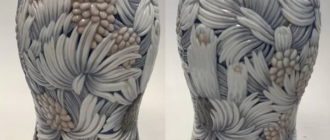
Fürstenberg porcelain has been produced for 270 years. This is the second oldest porcelain factory in Germany after the Meissen manufactory, which continues to operate today. The manufacturer has been successful for the third century thanks to the exceptional quality and artistic value of the products.
The rule adopted back in the 18th century helps to maintain a high level: all processes from mixing the mass to painting are carried out by the manufactory. Both modern and antique Fürstenberg porcelain are a welcome purchase for connoisseurs of beautiful things. It can be seen in expensive hotels, restaurants and at prestigious exhibitions.

When did Furstenberg porcelain appear?
Porcelain Fürstenberg owes its origin to Duke Charles I of Brunswick, on whose behalf the production was founded on January 11, 1747. It was headed by Johann Georg von Langen. The factory is located in the Fürstenberg hunting castle in the town of the same name. The castle was old: at the time of the opening of the manufactory, it was nearly 400 years old. Production was concentrated there until 1972. During this time, it was repeatedly repaired and rebuilt to accommodate the growing manufactory.

The first porcelain was produced at the Fürstenberg factory in 1750 after extensive experimentation. But kaolin was not yet part of the mixture recipe, so it was not classic hard porcelain. By 1753, the products reached the proper quality and began to be marked with the “F” mark, which still remains the trademark of the factory. Nowadays, the castle is a historical landmark and museum, which contains the largest collection of Fürstenberg porcelain. Here you can see how the style of dishes and sculpture has changed from the Rococo era to the present day. Porcelain is produced in the surrounding buildings.
The most famous models of Fürstenberg porcelain The manufactory began work in the Rococo era and in the first decades produced services, vases and sculpture in the rocaille style. Crockery with swirls on the handles is still being produced. But the change of artistic trends has always been reflected in the products of the German factory.

Here is a list of items key to her story, with release date:
- “1780”. When frivolous rococo is replaced by strict neoclassicism, the masters of the Fürstenberg manufactory create the Duke Ferdinand service with clear lines and angular handles;
- “1805”. Since the end of the 18th century, the factory has been run by the French artist Louis Victor Gerverot. Paying tribute to the Empire style, he creates an elegant Empire service, which combines the traditions of classicism and antiquity;
- “1888”. Manufactory is undergoing transformation, the management takes the form of a joint-stock company. Around this time, the romantic Grecque design with faceted walls is created;
- “1904”. The creative searches of the beginning of the 20th century were reflected in the dishes of Ariana. It is also interesting because for the first time Fürstenberg table, tea and coffee china could be purchased in one design;
- “1934”. Since the beginning of the 1930s, the manufactory has been cooperating with the Bauhaus art association. The result is a concise and functional Wagenfeld series that remains popular today;
- “2007”. In honor of the 260th anniversary, the Fürstin design, created in 1952, was updated. The new form – functional in a modern way, but thin and graceful – was called Victoria Luise.

In the 21st century, the Fürstenberg manufactory continues to produce original sets and vases, attracting world-famous designers to cooperate. For example, the Italian Carlo Dal Bianco designed the unusual shape of Carlo, while the Korean ceramist Kap-Sun Hwan designed the Aureole pottery, which features ancient Asian traditions.












